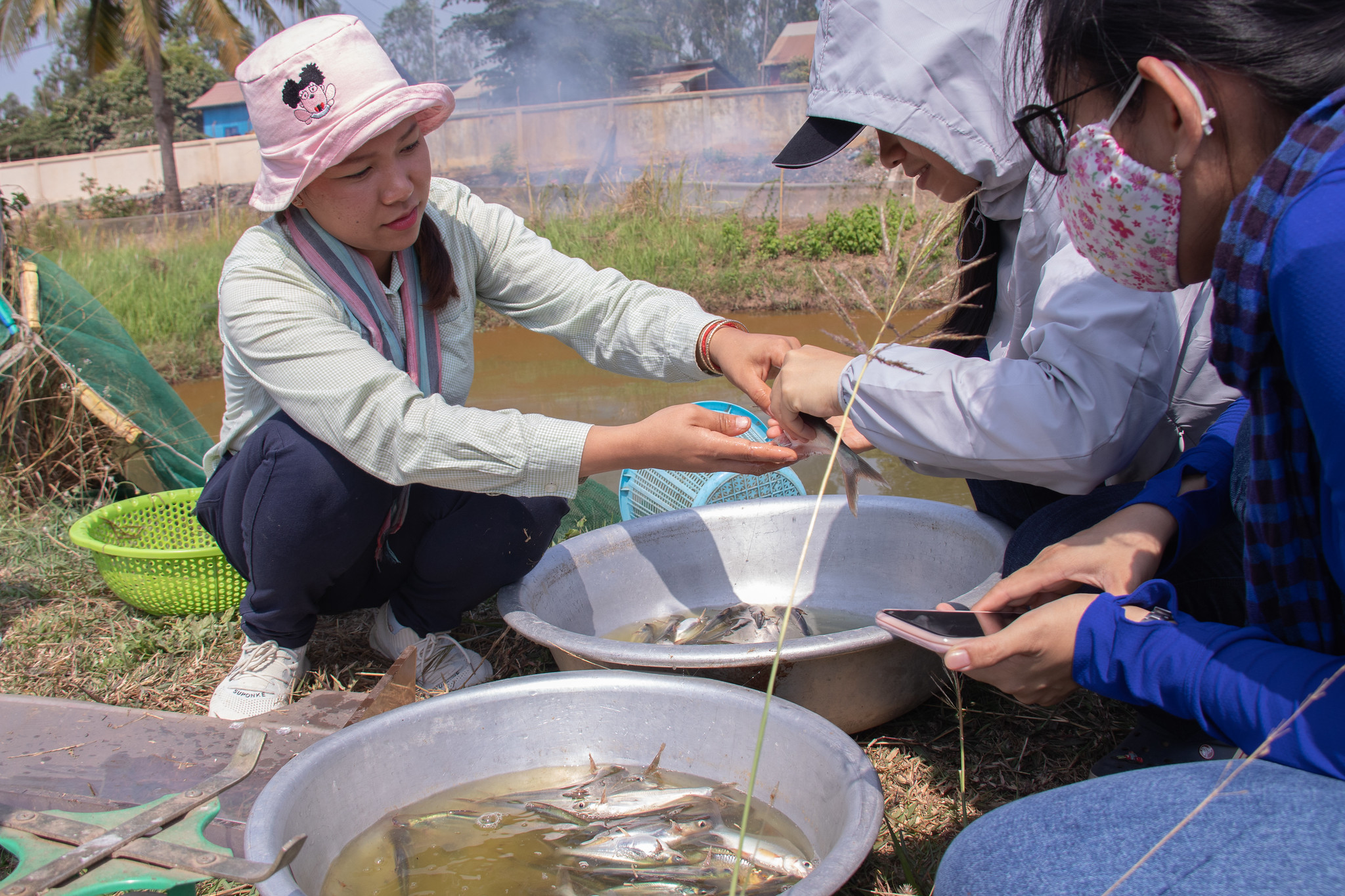
by Hoy Sreynov
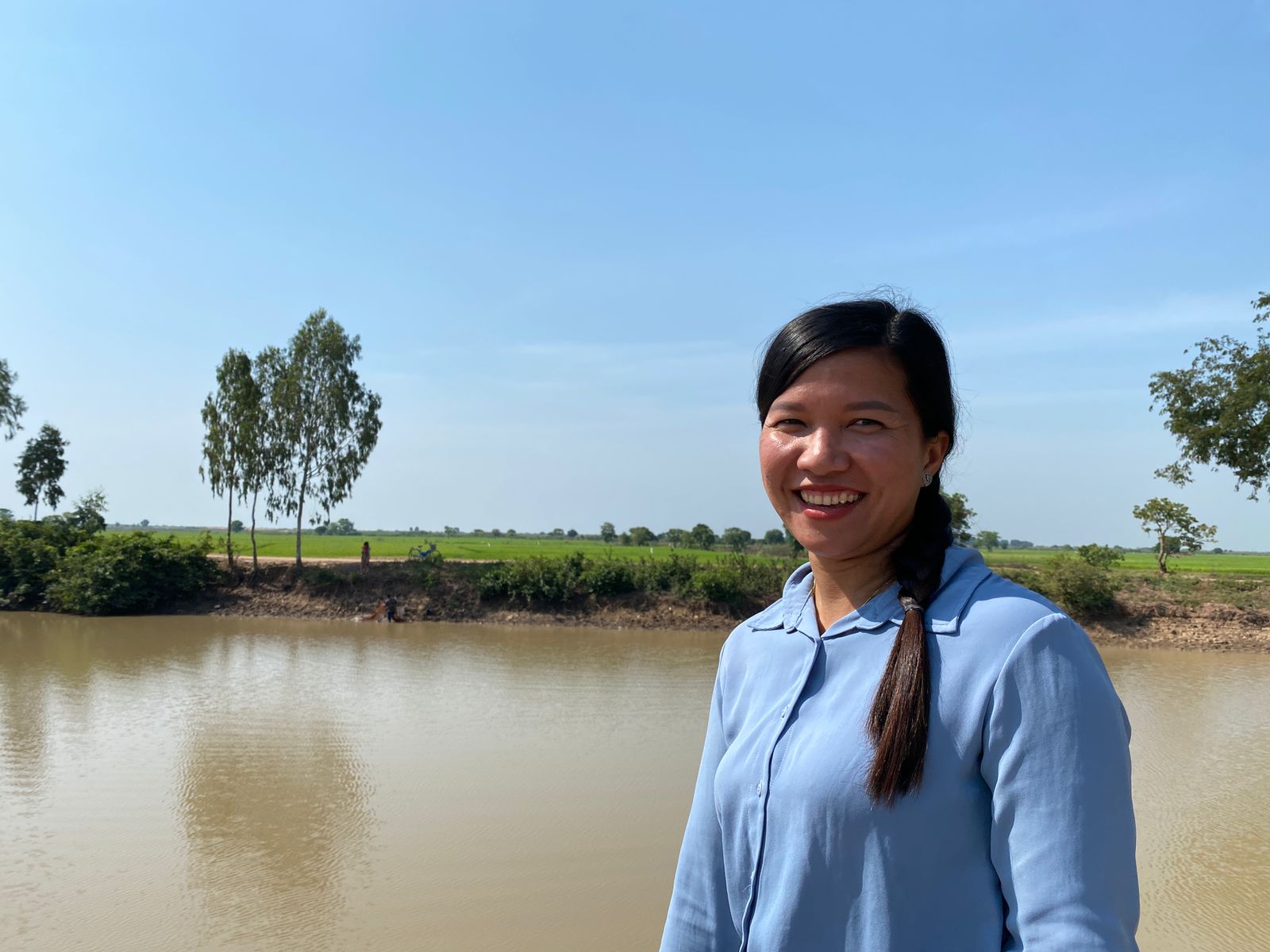 My name is Hoy Sreynov. I’m a government official for the Department of Aquaculture of Fisheries Administration, and I work on rearing fishes from the Mekong in ponds for conservation, especially giant barb and giant catfish. In 2018, the Director of the Aquaculture Department offered me the opportunity to be involved in the Wonders of the Mekong project through as part of aquaculture conservation activities. The aquaculture conservation component of the project focuses on collecting juvenile fish (called fry) from the Mekong River during the rainy season when the water level is high season. The fry are reared in experimental ponds due to the high rate of mortality rate in the wild (less than 1% of fry typically survive). In addition, some of the natural flooded areas that fish use for rearing have been destroyed. The rearing ponds for fishes from the Mekong is located at the FARDeC in Bati Village, Peam Roh Commune, Peam Roh District, Prey Veng Province. We expect that the survival rate would be higher for fish that rear in the safety of a pond, which is why we rescue those juvenile fish during the critical period as a conservation activity. After rearing in the ponds, some of the species will be tagged and released back into the wild; and some others will still be raised in the pond until they grow to be adults for breeding purposes.
My name is Hoy Sreynov. I’m a government official for the Department of Aquaculture of Fisheries Administration, and I work on rearing fishes from the Mekong in ponds for conservation, especially giant barb and giant catfish. In 2018, the Director of the Aquaculture Department offered me the opportunity to be involved in the Wonders of the Mekong project through as part of aquaculture conservation activities. The aquaculture conservation component of the project focuses on collecting juvenile fish (called fry) from the Mekong River during the rainy season when the water level is high season. The fry are reared in experimental ponds due to the high rate of mortality rate in the wild (less than 1% of fry typically survive). In addition, some of the natural flooded areas that fish use for rearing have been destroyed. The rearing ponds for fishes from the Mekong is located at the FARDeC in Bati Village, Peam Roh Commune, Peam Roh District, Prey Veng Province. We expect that the survival rate would be higher for fish that rear in the safety of a pond, which is why we rescue those juvenile fish during the critical period as a conservation activity. After rearing in the ponds, some of the species will be tagged and released back into the wild; and some others will still be raised in the pond until they grow to be adults for breeding purposes.
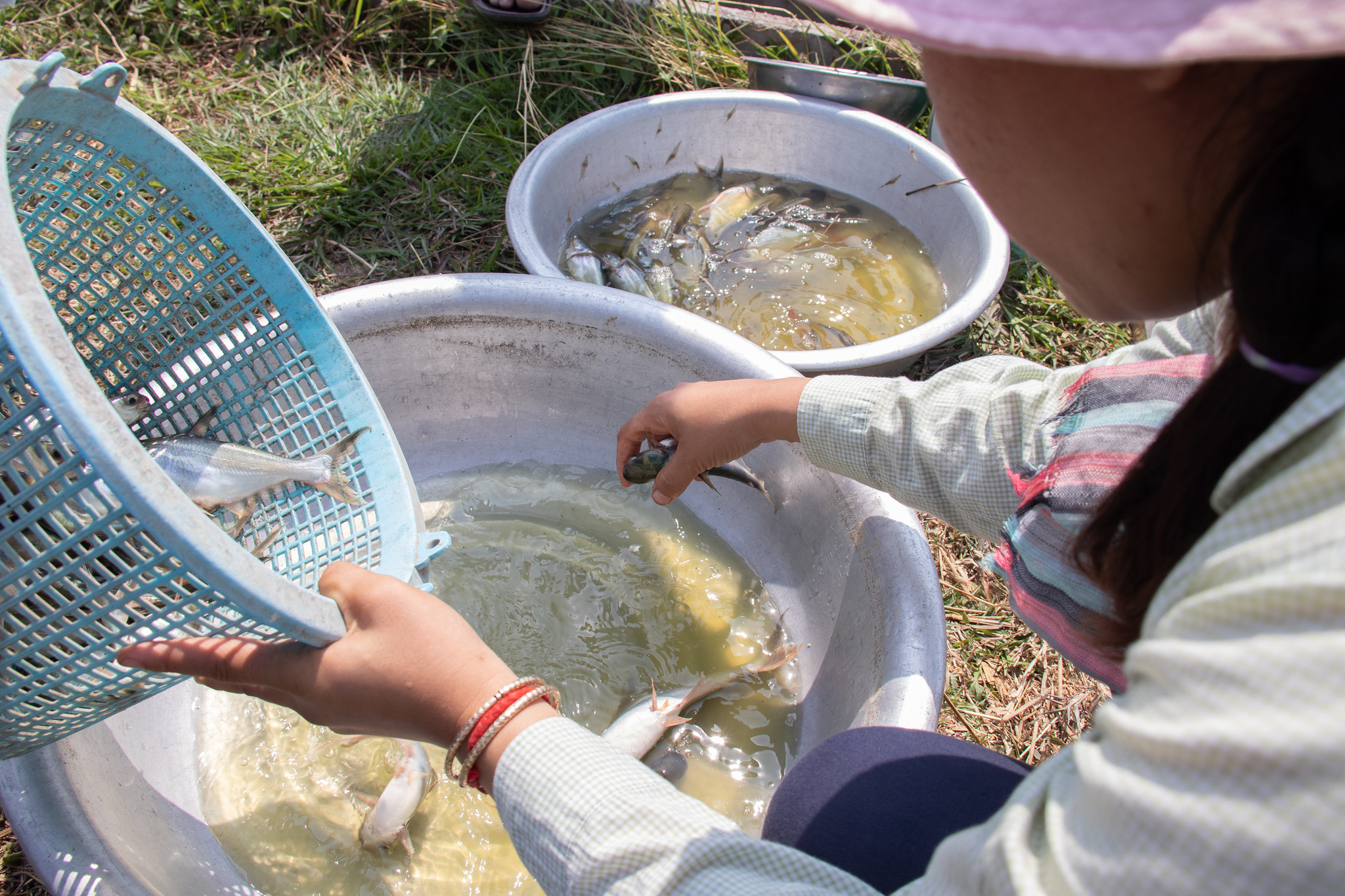
We have noticed that in the last decade, Cambodia’s natural fishery resources have significantly declined, and cannot adequately meet the daily needs of the population. Climate change, changes in flooding patterns, the use of illegal fishing gear, logging or burning of flooded forests that serve as important fish’s habitat, natural ecosystem destruction, and pollution of ocean and lake environments are all factors that seriously affect natural fisheries resources in the wild. Cambodia is blessed with the gigantic Tonle Sap Lake, the Mekong River, and other lakes that have provided hundreds of thousands of tons of fish for local consumption as well as export. Fisheries resources have been so abundant to the point that many people would never even think of eating farmed fish. However, we must now acknowledge that a large number of those natural fishery resources are no longer available to us. Some species are even critically endangered, with only a small number of individuals left these days. Aquaculture, which some people have never even thought about, plays a significant role in reducing pressure on natural resources, increasing incomes, increasing natural fish stocks, and ensuring food security and nutrition for Cambodians as well as other people in the world.
The problem I face is that some people are not yet aware that fish species are endangered (like the giant catfish and giant barb for instance), which makes their involvement in conservation work very limited. Some people still have the tendency to eat more wild fish rather than the farmed ones, which makes the price of wild fish even more expensive. Some fishers try in any way they can to catch fish, although they have to use illegal fishing gears. This causes a heavier burden on fisheries resources in the wild, leading to the risk of subsequent loss. If we remain indifferent to conservation work, I have no doubt that our younger generations will not see or know how glorious our natural fisheries resources are in Cambodia. On the other hand, if we know how to adapt to the social context, recognize what is new and what is true, progress will surely come. For example, if people knew more about aquaculture, they can understand that aquaculture not only helps the economy, it also reduces all of our pressure on natural fisheries resources. Their direct or indirect participation in conservation work can contribute to the protection and restoration of these natural fisheries resources for the benefit of the entire nation.
Hoy Sreynov is a 2020–2022 Mekong Conservation Hero selected by the Wonders of the Mekong Project.
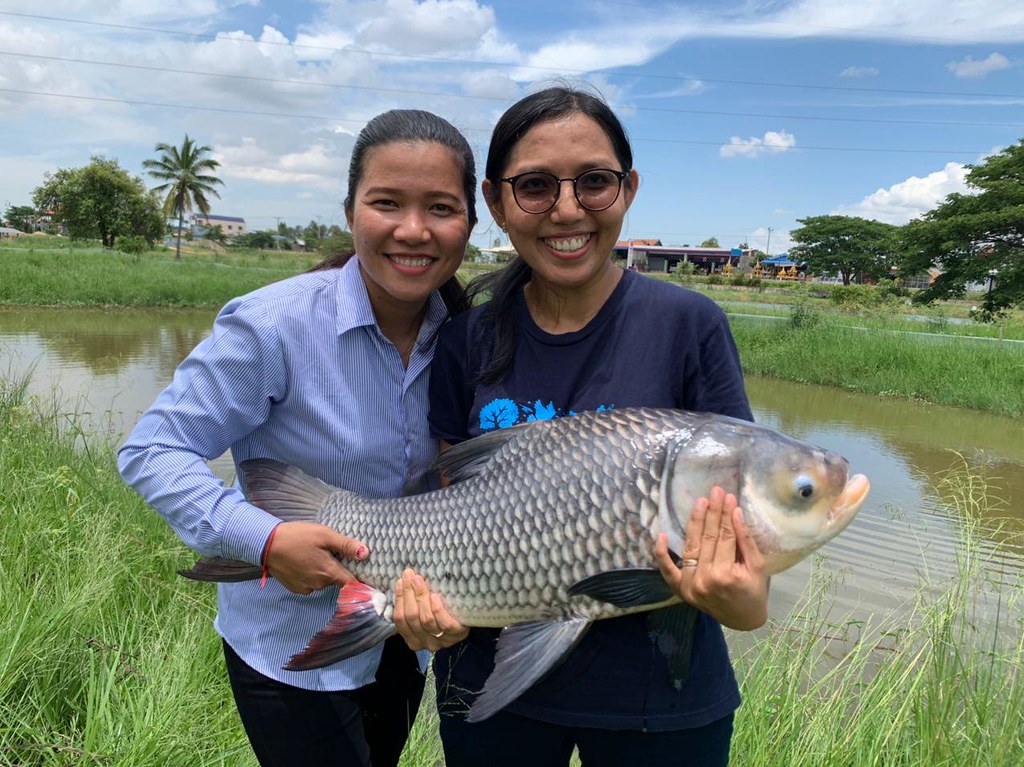
នាងខ្ញុំឈ្មោះ ហូយ ស្រីនៅ ជាមន្ត្រីនាយកដ្ឋានអភិវឌ្ឍន៍វារីវប្បកម្ម នៃរដ្ឋបាលជលផល។ នាងខ្ញុំជាមន្ត្រីមួយរូប ដែលធ្វើការជាមួយការងារថែបំប៉នប្រភេទត្រីទន្លេមេគង្គ ជាពិសេសត្រីគល់រាំង និងត្រីរាជនៅក្នុងស្រះ។ កាលពីឆ្នាំ២០១៨ នាងខ្ញុំបានទទួលឱកាសពីលោកប្រធាននាយកដ្ឋាន ដើម្បីចូលរួមការងារជាមួយគម្រោងអច្ឆរយៈភាពនៃទន្លេមេគង្គ តាមរយៈគម្រោងអភិរក្សវារីវប្បកម្ម។ គម្រោងអភិរក្សវារីវប្បកម្មផ្តោតសំខាន់ទៅលើការប្រមូលកូនត្រីម្ស៉ៅពីទន្លេមេគង្គនៅរដូវទឹកតំឡើង យកមកផ្សាំបំប៉នក្នុងស្រះព្រោះអត្រាបាត់បង់របស់កូនត្រីម្ស៉ៅនៅក្នុងធម្មជាតិមានកម្រិតខ្ពស់ (អត្រារស់តិចជាង១ភាគរយ) ខណៈដែលតំបន់លិចទឹកធម្មជាតិមួយចំនួនត្រូវបានបំផ្លាញ។ ស្រះថែបំប៉នកូនត្រីធម្មជាតិទន្លេមេគង្គ មានទីតាំង នៅមជ្ឈមណ្ឌលស្រាវជ្រាវ និងអភិវឌ្ឍន៍វារីវប្បកម្មទឹកសាប (FARDeC) ភូមិបាទី ឃុំពាមរក៍ ស្រុកពាមរក៍ ខេត្តព្រៃវែង។ ការថែបំប៉ននៅក្នុងស្រះ យើងរំពឹងថាអត្រារស់របស់វានឹងបានខ្ពស់ ដែលជាឱកាសមួយជួយសង្គ្រោះកូនត្រីទាំងនោះនៅដំណាក់កាលដំបូង ហើយវាជាសកម្មភាពអភិរក្សមួយផងដែរ។ បន្ទាប់ពីធ្វើការថែបំប៉នក្នុងស្រះត្រីមួយមួយចំនួននឹងត្រូវបានពាក់ស្លាកលែងចូលធម្មជាតិវិញ ហើយត្រីមួយចំនួនទៀតនឹងបន្តចិញ្ចឹមបំប៉ននៅក្នុងស្រះរហូតដល់ពេញវ័យបន្តពូជសម្រាប់ធ្វើការបង្កាត់ភ្ញាស់។
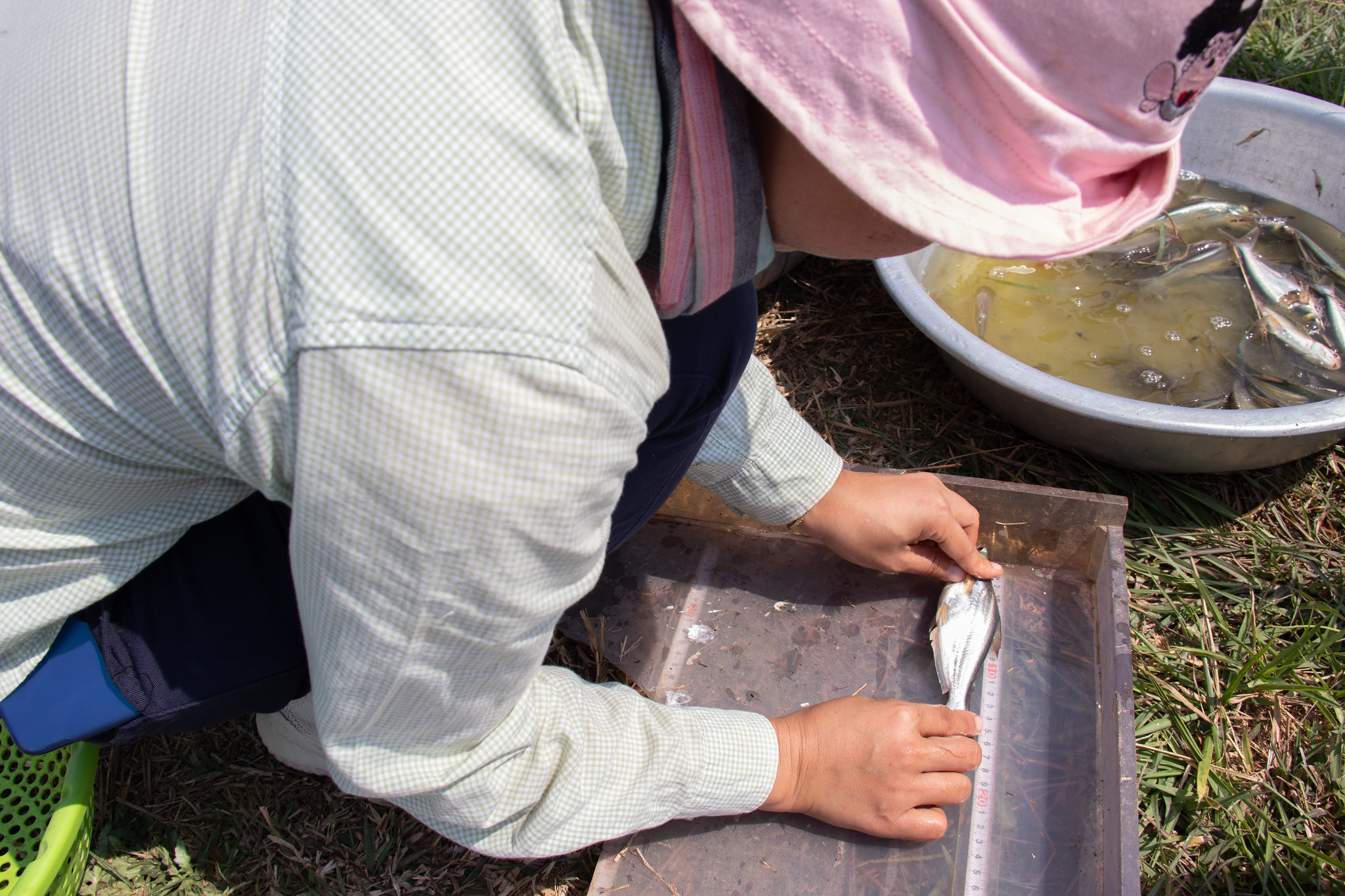
ក្នុងរយៈពេលមួយទស្សវត្សចុងក្រោយនេះ យើងសង្កេតឃើញថាធនធានជលផលធម្មជាតិកម្ពុជាមានការថយចុះខ្លាំង ដែលមិនអាចផ្គត់ផ្គង់តម្រូវការប្រើប្រាស់ប្រចាំថ្ងៃរបស់ប្រជាជនបានគ្រប់គ្រាន់ឡើយ។ ការប្រែប្រួលអាកាសធាតុ ការផ្លាស់ប្តូររបបទឹកជន់ ការប្រើប្រាស់ឧបករណ៍នេសាទខុសច្បាប់ ការកាប់ឬដុតបំផ្លាញព្រៃលិចទឹកដែលជាជម្រកមច្ឆជាតិ ការបំផ្លាញប្រព័ន្ធអេកូឡូស៊ីធម្មជាតិ ការចាក់លុបសមុទ្រ បឹងបួរ សុទ្ធតែជាកត្តាដែលធ្វើឱ្យប៉ះពាល់យ៉ាងធ្ងន់ធ្ងរដល់ធនធានជលផលធម្មជាតិ។ កម្ពុជា ដែលមានបឹងទន្លេសាបដ៏ធំល្វឹងល្វើយ ទន្លេមេគង្គ ស្ទឹង បឹងបួរ កន្លងមកបានផ្គត់ផ្គង់ត្រីរាប់សែនតោនសម្រាប់ការប្រើប្រាស់ក្នុងស្រុក និងនាំចេញ រហូតដល់ប្រជាជនមួយចំនួនមិនដែលនិងគិតចង់បរិភោគត្រីចិញ្ចឹមឡើយ។ ប៉ុន្តែមកដល់បច្ចុប្បន្នយើងត្រូវទទួលស្គាល់ថាធនធានធម្មជាតិទាំងនោះ មួយចំនួនធំមិនបាននៅសម្រាប់ផ្គត់ផ្គង់ដល់យើងទៀតឡើយ គឺវាបានបាត់បង់ហើយ ហើយមួយចំនួនទៀតកំពុងរងគ្រោះជិតផុតពូជ នៅសល់បរិមាណតិចតួចប៉ុណ្ណោះសម្រាប់ផ្គត់ផ្គង់ដល់យើងសព្វថ្ងៃ។ វារីវប្បកម្ម ដែលប្រជាជនមួយចំនួនមិនដែលសូម្បីនឹងគិត វាបានចូលរួមចំណែកយ៉ាងសំខាន់ក្នុងការកាត់បន្ថយសម្ពាធទៅលើធនធានធម្មជាតិ បង្កើនប្រាក់ចំណូល បង្កើនផលស្តុកធម្មជាតិ ធានាសន្តិសុខស្បៀង និងអាហារូបត្ថម្ភជូនប្រជាជនកម្ពុជា ក៏ដូចជាប្រជាជនលើពីភពលោក។
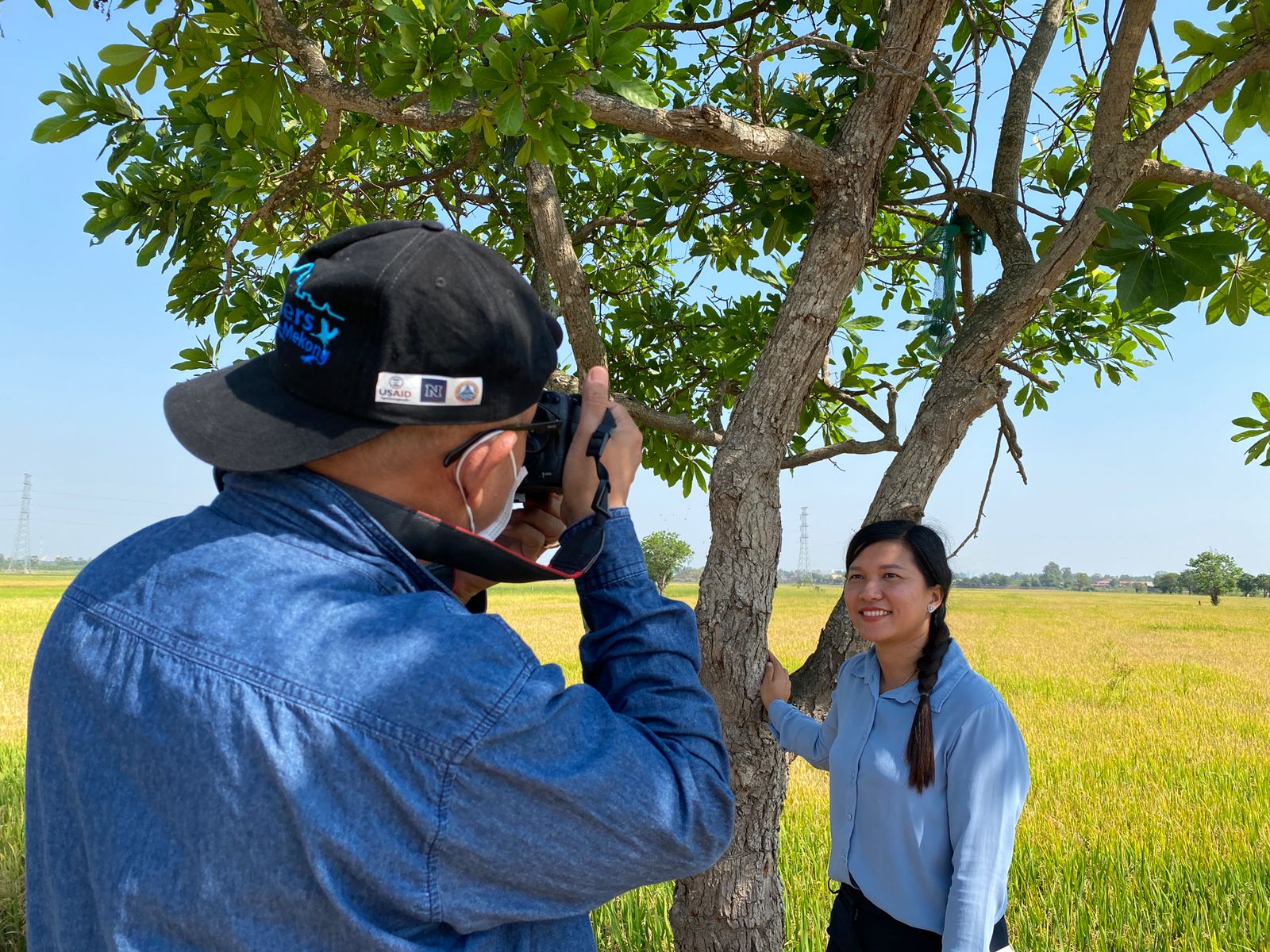
បទពិសោធន៍ទាំងនេះ បានធ្វើឱ្យខ្ញុំប្រឹងប្រែងកាន់តែខ្លាំងមិនថាការងារអភិរក្ស ឬការងារអភិវឌ្ឍន៍វារីវប្បកម្មនោះទេ ព្រោះការងារទាំងពីរនេះវាមានទំនាក់ទំនងទៅវិញទៅមក។ តាំងពីឆ្នាំ២០១៧ មកដល់បច្ចុប្បន្ន តាមរយៈគម្រោង គឺយើងបានធ្វើការប្រមូលកូនត្រីធម្មជាតិពីទន្លេមេគង្គមកថែបំប៉នក្នុងស្រះ ដោយមានការផ្តល់ចំណី ត្រួតពិនិត្យគុណភាពទឹក និងតាមដានការលូតលាស់យ៉ាងយកចិត្តទុកដាក់។ ត្រីទាំងនោះគឺយើងមានការបែងចែកតាមប្រភេទ តាមឆ្នាំ និងតាមស្រះបំប៉នដាច់ដោយឡែក ដើម្បីងាយស្រួលដឹងពីសាវតារបស់ត្រី។ មិនត្រឹមតែប្រមូលកូនត្រីពីធម្មជាតិនោះទេ គម្រោងបានទទួលត្រីរាជ និងត្រីគល់រាំងពីប្រជានេសាទ និងវារីវប្បករជាបន្តបន្ទាប់សម្រាប់ធ្វើការថែបំប៉ន មុនពេលលែងចូលទៅក្នុងធម្មជាតិវិញ។ ការបង្កាត់ភ្ញាស់ត្រីមេពូជប្រមូលបានពីធម្មជាតិ នឹងធ្វើឡើង ដើម្បីបានកូនត្រីដែលមានសុខភាពល្អ សម្រាប់លែងចូលក្នុងធម្មជាតិវិញ និងផ្គត់ផ្គង់ដល់វារីវប្បករសម្រាប់ការចិញ្ចឹម។ មេពូជត្រីធម្មជាតិដែលប្រមូលបាន បានឧបត្ថម្ភដល់មជ្ឈមណ្ឌល និងវិទ្យាស្ថានសម្រាប់ធ្វើការរក្សាទុកប្រើប្រាស់ទៅថ្ងៃខាងមុខផងដែរ។ ដោយឡែកប្រភេទត្រីមួយចំនួនដែលបំប៉នក្នុងស្រះ បានយកទៅលែងក្នុងព្រឹត្តិការណ៍ផ្សេងៗ ដូចជាទិវាមច្ឆបំលាស់ទីពិភពលោកជាដើម ក្នុងគោលបំណងផ្សព្វផ្សាយពីការងារអភិរក្សឱ្យប្រជាជនទូទៅបានដឹង។